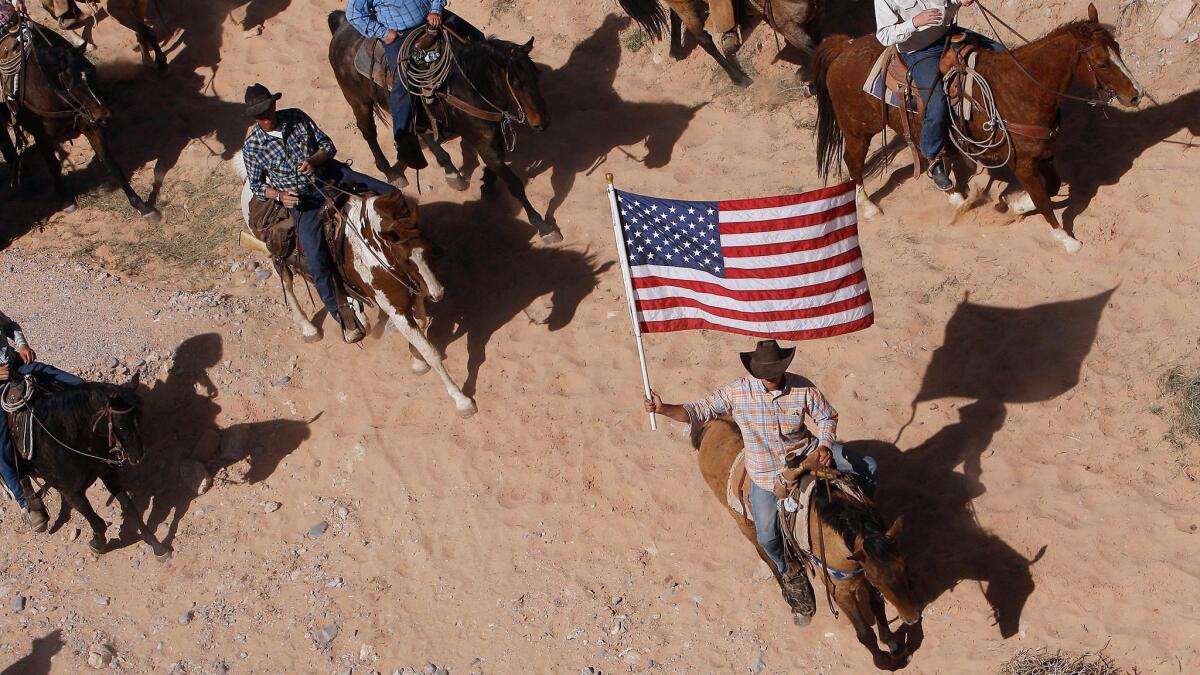Op-Ed: The Bundys are poster boys for America’s rural/urban divide

- Share via
Cliven, Ammon and Ryan Bundy went on trial in Las Vegas last week over their violent standoff with Bureau of Land Management officials in Nevada in 2014. Cliven had refused to stop grazing cattle on federal land, or to pay grazing fees. BLM agents trying to collect the cattle abandoned the effort when they were met by several hundred militant Bundy supporters. You may also remember Ammon and Ryan, Cliven’s sons, from another “rancher protest,” the occupation of the federal Malheur Wildlife Refuge in Oregon in early 2016.
These armed standoffs are indefensible. But they are also symptomatic of bigger problems that weigh on our society. Longstanding tensions over Western federal land and deep conflicts between city “elites” and country “non-elites” help explain why some view Cliven Bundy as a folk hero and others see him as a domestic terrorist. These divisions could also account for a slew of not-guilty verdicts in four earlier trials related to the standoffs.
Cliven Bundy’s gripes are nothing new. Westerners with similar attitudes have engaged in low-level warfare against the federal government for decades. Anti-federal movements demanding local control of public land have gone by several names, including the Sagebrush Rebellion and the Wise Use Movement. The Bundys and their “uprisings” fit a pattern of armed, anti-government insurrectionism.
For those of us who think the federal government and public lands are worthwhile, a potential solution to differences over land use would be better collaboration between locals and federal agencies. More transparency and participation might not fully defuse extremist ideas about government tyranny, but they couldn’t hurt. As environmental law scholars at the University of Montana said in a recent paper, U.S. land use agencies — among them BLM, the Fish and Wildlife Service, the National Park Service and the Forest Service — now lack “any standardized process that would allow for … uniformity in how local governments” can be involved in agency planning.
In rural areas, there’s likely to be more sympathy for the idea that Bundy’s long use of the land gave him a right to do what he wanted with it.
Beyond a difficult bureaucracy, a cultural gulf feeds anti-Washington sentiment in the West. The urban/rural divide received some attention before the 2016 presidential election, in books such as “Hillbilly Elegy.” Since the election — now portrayed as a great reckoning by rural voters — mainstream America understands that outside cities and suburbs, people may feel forgotten and looked down on.
They have good reason. The deregulation of the transportation industry in the 1980s left many towns isolated when airlines and bus lines pulled their services out of less accessible regions. Globalization, the shift away from manufacturing and natural resource extraction, and the rise of industrialized agriculture greatly undermined the rural economy. Census data show that rural business formation plummeted after the 2008 recession. High rates of poverty persist in rural areas, fueling public health crises such as the opioid and suicide epidemics. UC Davis law professor Lisa Pruitt and other scholars, assessing legislation, court outcomes and policy data, conclude that even the law is “urban normative,” undermining rural residents’ quality of life and access to justice.
Property rights are a key symbol of the urban/rural divide. According to social science and legal scholarship, rural residents are more likely to associate land with absolute ownership — it’s mine and I can do what I want with it. Urban residents, on the other hand, are more used to obeying rules that limit property freedoms to make city life more livable for all. For urbanites, ranchers’ claims of property rights in federal lands can be dismissed with arguments based in the law — Cliven just had a lease to graze his cattle, the land was never his. In rural areas, there’s likely to be more sympathy for the idea that Bundy’s long use of the land gave him a right to do what he wanted with it, even without a formal legal entitlement.
These explanations do not excuse the Bundys’ conduct. Obviously, most residents in rural areas do not take up arms against the government, and poll data show that a significant majority in all Western states but Utah support keeping federal lands federally owned. Nonetheless, the government has suffered one stinging defeat after another in prosecuting the militants who confronted the BLM in Nevada and took over the Malheur refuge in Oregon. Eleven of the 17 defendants tried by juries so far have walked free; among those convicted (and a few who pleaded guilty), it was mostly on lesser though still serious charges.
Some observers argue that prosecutors didn’t build strong enough cases. But one of the jurors from the first of the Malheur trials accused the prosecution of “arrogance” and an “air of triumphalism” — which hints at a trademark rural view: federal representatives as elitist outsiders.
The current trial includes the highest profile Bundys and one of their supporters, Ryan Payne (two more Bundy sons will be tried later with yet another group of defendants). Cliven and company face charges involving conspiracy, assaults and threats against federal officers, use of a firearm in a violent crime, obstruction of justice and extortion. It’s possible prosecutors will have a better shot at getting an unequivocal guilty verdict this time. “We ran them out of here,” Ammon Bundy once boasted about the feds in Nevada. “We were serious. We weren’t playing around.”
Then again, it’s up to the Las Vegas jury. In a motion the judge denied, the defendants argued that an urban jury would be biased against them. How urban, though, is a sprawling city in the middle of the desert? The jurors may not like the Bundys, but they may like the prosecutors even less.
Ann Eisenberg is an assistant professor of law at the University of South Carolina School of Law.
Follow the Opinion section on Twitter @latimesopinionand Facebook
More to Read
A cure for the common opinion
Get thought-provoking perspectives with our weekly newsletter.
You may occasionally receive promotional content from the Los Angeles Times.










